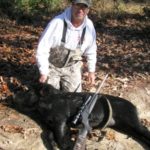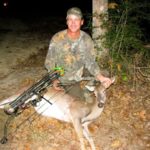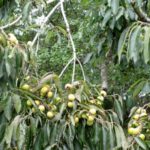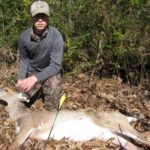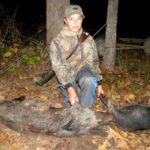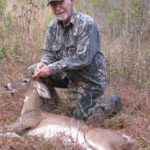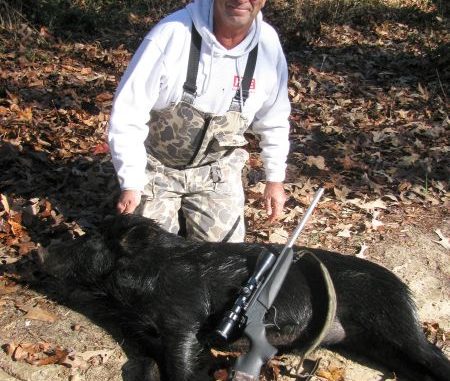
He’s talking hogs and deer on WMA, not LSU’s football game
“Kickoff’s at seven,” Artie reminded. “So we wanna get the backstraps in the smoker by mid-afternoon. Y’all be back by then, huh? And with some backstraps? Heck we need to marinate ’em a little beforehand.”
“Heck, we should be back by noon,” Pelayo laughed, “in plenty time with plenty meat! Just make sure you guys are back with some fish for the grill.”
Artie’s “kickoff” meant the “Da Big Game” for October: The LSU-Ole Miss game, which we’d watch in royal splendor. Just when you thought he couldn’t possibly buy a fancier accoutrement for his “camp” on Lake St Catherine, Doc comes up with a 60-inch plasma TV!
So he moved that rinky-dink 40-incher into the “guest bedroom,” occupied this weekend by Spencer and Tricia.
The “His and Her” Ducks Unlimited bathrobes and the new issues of Sporting Classics and Vogue had alerted us to these guests.
“But no chocolates on the pillows?” Artie laughed at the smirking Doc.
The game would be the premier of the 60-incher. So we were pumped, especially with “Da Tigers” looking tough.
We expected a bruising knock-out, drag-out match in Doc’s den, and that was after the game. That’s when, regardless of the final score, the pro- and anti-Les Miles forces would roll up their sleeves, put on their game faces, and rip into each other like real tigers!
Whoo-Boy!
As luck would have it the first real cool front of the year had barreled through a couple of days earlier. This meant absolutely ideal conditions for the deer/swine foray Pelayo and I had planned on the lower Pearl River WMA.
From Doc’s camp we’d get there and back in a flash by boat, while the rest of the gang went fishing.
Boating-in key to WMA
Boat access is the key to successful hunting in this enormous and game-filled WMA, which is also bramble-thick, mushy-bottomed, and hard-to-access.
“Most people hunt right off old (U.S. Highway 11) or what many call ‘da oil well road,’” explains the area’s ace biologist Chris Winslow. “For years all the blowdowns from Katrina had made that upper portion of the WMA really difficult to hunt.
“Now all the tree damage is actually good for the deer, making for lots of great habitat and especially for plenty browse. But it made getting into the place really difficult, and very few hunters were up to it. By now, however, that upper area has cleared up a bit and more hunters are using it.”
Among the most proficient of these is Jim “Jimbo” Laborde of Metairie.
“Sure it can get crowded in that area, but most hunters aren’t really up to walking very far off the main trails, ” Laborde said. “I get in there and really do some hiking, then still hunt along the transition zones, where the thick brambles and briar patches that grew up in the open areas after the hurricane meet up with more open hardwood bottoms.
“During daylight, those pigs aren’t very far from thick cover, usually right on the edge of the briar thickets. By hiking in deep, getting away from the crowds, and actually using them to drive the game to me , I never have much trouble finding pigs in the upper WMA. Heck, it’s rare if I only see one or two; usually I find small herds of them.”
Winslow recommends using a boat.
“Generally speaking the better hunting for deer and hogs comes by accessing the area by boat,” he said. “And it doesn’t require a big or fancy boat. It’s really within reach of anyone willing to put in a little extra effort.”
Finding transition areas
Indeed, very shrewdly Pelayo and I had zeroed in on the portion of Pearl River WMA where the cypress/tupelo swamp starts giving way to fresh marsh. Cypress trees, with their immense root networks, are tough, and literally stand up to hurricanes much better than the limber swamp maples and willows, and even the water oaks.
This means the areas around them, especially a grove of cypress, remained relatively clear and still provided relatively open shooting lanes, even by the standards of south Louisiana swamp hunting.
It was exactly these areas that Pelayo and I had “scouted” while “poych-joyking” (panfishing) in the area a few weeks earlier. As well known by deer-hunters, transition zones from one type of habitat to another, — however trivial they might appear to the naked human eye, concentrate deer movement.
In brief: Wherever terrain types meet, deer trails appear.
Often it’s an area no more dramatic in transition than, say, where a 5-year-old clear-cut meets a 10-year-old clear-cut. Or where a select-cut area meets an unlogged area or a clear-cut area, or a select-cut area that’s a few years older. Where upper pinelands dip down to laurel and willow oak bottoms, we usually find deer trails. Then, where these oak bottoms give way to cypress-tupelo overflow areas we find more.
In our coastal wetlands, we generally find the trails not so much on top of the spoil bank itself as along its inside edge, where the bacchiris, elderberry and willows start giving way to elephant ears and alligator grass.
For this Pearl River hunt, however, we’d zeroed in on a truly dramatic transition zone where the WMA’s cypress-tupelo swamp transitions to fresh marsh just north of Highway 90.
Best of all, this fresh marsh is absolutely covered with deer pea (Vigna Luteola). This wetland vine got the name for a reason: Deer love it, but it’s mostly withered by the gun season. In mid October, however, most of the leaves and vines are still green, though the actual pea pods may have browned.
No matter, deer munch out on it big time. Find a thick patch of deer pea and it’s among the best natural food plot available in any deer habitat. It’s right up there with a grove of white oaks in more upland areas. Heck, it’s right up there with the very cow peas you plant on your lease.
And we’d found without much difficulty a huge patch of the stuff. Even better, following the trails briefly into the wooded swamp behind the patch, we came upon a small grove of persimmons on a little ridge. These slender trees were dropping their sweet and scrumptious soft mast to the obvious delight of the area’s deer and swine. The little ridge was churned like a pasture with tracks, both deer and swine.
“Whoo-boy!” Pelayo whooped with a wide-eyed look when we’d found the place while scouting. We were pumped.
Both persimmons and deer pea, by the way, are mostly gone by the gun season. So we make it a point to take advantage of these super-attractive natural food plots in October.
Scary boat ride
By 4:30 a.m., as the rest of the gang snoozed away in luxurious comfort, Pelayo and I were already heading for this honey hole in his 16-foot flat. Now keep in mind, navigating the Middle Pearl upstream from Highway 90 during low water in broad daylight is a hair-raising experience in itself.
Navigating it in pitch blackness packs a much bigger adrenaline buzz.
Weaving through this maze of logs and blowdowns and sand and mud bars is a task best reserved for sportsmen with ample experience on the Pearl, those “river rats” hatched and bred in places like Slidell, Talisheek, Pearl River and Lacombe. You know, the guys who run trotlines in the river, fish for bass and white perch there, who travel its winding length looking for those pristine pockets of wilderness in the WMA where huge swine lurk and where bucks grow those long tines and heavy beams that come with age and a rich diet.
These guys know every bend of this river, every blowdown and sandbar; they’ll get you safely through the Pearl’s treacherous path at night and into the remote interior. Unfortunately, we had no one like that on board.
In fact, we had no one even close.
Pelayo manned the wheel and bellowed directions while I swept the river ahead with the Q-beam. Somehow we made it.
I had already picked a swamp maple overlooking an area where three trails — deer and swine, it appeared — were churned with tracks through huge mats of deer pea leading back into the persimmon ridge. I humped up my climber, hung up the bow and got semi-comfortable.
Pelayo took the boat a bit further north. Cradling his .22 mag, he’d make a big sweep behind and around me in his still-hunt quest for swine.
“Who knows?” I surmised. “He might drive something to me.”
Swamp comes alive — or not
We were both cranked to full voltage in anticipation, even sweating a bit in the 46-degree dawn, which is delightful for October.
In the twilight, shortly after I got comfortable in my perch, I seemed to be surrounded by three deer. Then the sun had to emerge and spoil it — the one right under me turned into a log; the one on my left became a stump; and, the one in front of me was a wilted palmetto leaf.
An hour later a browsing doe’s nose turned into a blackbird swaying on a branch.
A 6-point twitching his ear turned into a thrush twitching his tail.
And, a buck making a scrape became a rooting raccoon.
The human capacity for wishful thinking peaks on a deer stand. In no other setting is the human imagination busier, the senses keener, the powers of reasoning more defunct.
By 8:15, I was already getting fidgety. The squadrons of wood ducks blazing overhead were long past gone. But think about it, how many of those brochures in hotel lobbies in the French Quarter beckon you to embark:
• “on a charming tour of a 5-year-old pure-pine plantation?”
• “on a picturesque tour of a 10-year clear-cut timber tract?”
• “on a breathtaking tour of scenic landscape comprising select-cut timber featuring scenic logging machinery ruts, gorgeous burnt stumps and piles of cut-downs?”
• “with us and gaze bleary-eyed for four hours down a power-line surrounded by monotonous even-growth pines!”
I apologize for that question, but let’s face it,what most of us call deer hunting nowadays is mostly sitting around and scanning some hideous (for a normal person) panorama waiting for a sign of movement, then for perhaps a flash of brown, then (for fanatics and true aficionados) perhaps a flash of antler.
But as I focused on this wetland scenery I quickly became mesmerized.
“No wonder so many swamp tour operators popped up around here,” I smirked to myself. Let’s face it, if you’ve chosen a form of hunting that requires long, motionless vigils, why not find yourself surrounded by such a gorgeous panorama.
“Geezum?” I sighed to myself as the vigil progressed and no deer appeared. “You mean they’ve already gone nocturnal?”
Hunt gets exciting
Then, to my left, movement!
I jerked my head, and, foolishly in the excitement — it had been nine months and I was out of practice, I lunged for my hanging bow.
When I grabbed it and looked down, the little four-point was looking straight at me from maybe 45 yards.
What now? I hadn’t even drawn the bow yet and it was a nerve-rattling stand-off. I didn’t stand a chance to draw, aim and release while he stood still. He was obviously young, but he wasn’t a complete idiot.
So I tried to remain motionless, thinking he might relax and keep walking towards me through the patch of deer pea. A 45-yard shot is too long for me. But, in those seconds I was convulsed in shakes; I mean I was seriously rattled.
You’d really think after 35 years of habitual deer-hunting, a small deer wouldn’t do this to me? But it does, and that probably explains why I keep deer hunting.
“Oops!” I said to myself as he turned and ambled away.
In less than half a minute the stand-off was over and I was sitting in a tree shaking like David Byrne in his Once in a Lifetime video.
Finally the deer slipped into a thick area of tall wax myrtles about a hundred yards away. Just as I was calming down, after about 15 minutes, a flash of orange caught my eye to my left. It was Pelayo, weaving his way through some thickets.
Then: “POP!”
Pelayo’s rifle blasted. I jumped, and looked over.
“POP!” He shot again, and I jumped again.
“Geezum!” I thought. “He musta got into a herd!”
“POP!” Now a third shot, and I was really getting excited.
“Coming your way!” Pelayo yelled. “Hogs, a herd, coming right at ya!”
I lifted the bow, mostly for the principle of the thing. No way would I take a running shot. Then I saw one, and he stopped. I started aiming …
“POP!”
The pig I was watching flipped like a head-shot rabbit. Pelayo popped him, not 50 yards away.
My knees were knocking crazily again as I finally humped down the tree a few minutes later, just as Pelayo walked up, grinning like the Cheshire cat.
“Got TWO!” he roared as we high-fived. “It was a whole herd of the little suckers. I put them up in the thickets by the persimmons.”
We got back to Doc’s by noon-30, plenty enough time to marinade the swine backstraps and hindquarters. I was giving them a final basting when Doc’s den detonated with wails of woe. Even on the deck the eruption almost deafened me.
Yep! Ole Miss’ Andrew Ritter had just kicked that famous final field goal, upsetting LSU, 27-24.
“Whoo-boy!” I thought to myself. “Now the fun really starts!”
Sure enough, when I walked in: a red-faced Artie was just warming up: “Told ya dat Les Miles was….!”
